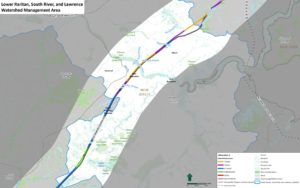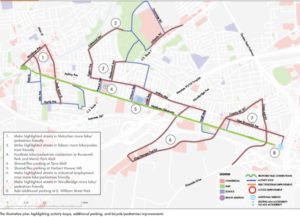Transportation Assets in the Lower Raritan Watershed
By Elizabeth Dabundo and Heather Fenyk
Continuing the LRWP’s 2016 Natural Assets Mapping Speaker Series, on April 19 we welcomed Devin Gargan of AECOM and Nick Tufaro from the Middlesex County Office of Planning to discuss the topics of transportation and mobility assets in the Lower Raritan Watershed. Transportation is an important dimension of the concept of sustainability, and research into the environmental impacts of how we move to and from work, school and play involves everything from vehicle emissions to green supply chain management practices. Developing transportation systems for the future in a way that minimizes environmental impacts and maximizes environmental sustainability requires close study of the reciprocal influence between the physical environment and transport infrastructures, including careful analysis of geographical location, topography, geological structure, climate, hydrology, soil, natural vegetation and animal life.
Encouraging the use of mass transit through Transit Oriented Development, and encouraging non-motorized transportation through municipal planning that includes “Complete Streets” and a commitment to connectivity of pedestrian and bicycle networks, are both ways to reduce the negative environmental impacts of vehicular travel. Of course, however, there are also significant environmental impacts associated with the installation of new rail lines and tunnels. We discussed issues of sustainability as well as the potential environmental impacts of expanding our transportation infrastructure with Mr. Gargan and Mr. Tufaro. It was an extremely informative and interesting morning!
First, Devin Gargan of AECOM spoke about a recent planning exercise conducted by the Federal Rail Administration on the future of the Northeast Corridor Rail Line. (The completed report “NEC Future: A Rail Investment Plan for the Northeast Corridor” can be accessed here: http://www.necfuture.com/). The Northeast Corridor cuts through the Lower Raritan Watershed, connecting Boston to Washington DC. It spans 457 miles, carries 2,200 daily trains, and 750,000 daily passengers.
AECOM is working with the NEC, Federal Railroad Administration, Federal Transit Administration, communities along the rail line and others to upgrade aging infrastructure and improve reliability, capacity, performance, and resiliency of passenger rail service on the NEC for both intercity and regional trips, while promoting environmental sustainability and economic growth. Mr. Gargan presented on three alternatives to maintain, grow, or transform NEC rail service. In January the LRWP submitted written comments to AECOM highlighting the potential environmental impacts of these alternatives to the Raritan River and the Lower Raritan Watershed. While we acknowledged the environmental benefits of reducing vehicular miles travelled through expanded rail service, we emphasized the need to involve environmental stakeholders in Tier 2 Service Development Planning for any of the alternatives.
NEC Future Alternative 3, Lower Raritan Watershed. Image: AECOM
Alternative 1 maintains the role of rail as it is today, keeping pace w/ demographic change.
Alternative 2 grows the role of rail with service to new markets and more frequent intercity and regional trains looking at connecting markets. In central NJ Alternative 2 proposes a new rail segment that begins in North Brunswick and runs parallel to the NEC all the way to Seacaucus. This new segment includes creation of a tunnel running underneath the Raritan River between New Brunswick and Highland Park through to Metuchen and Edison.
Alternative 3 builds on Alternative 2 to transform the role of rail in the region with a second spine supporting faster trips and service to new markets, including an extension through North Brunswick.
AECOM is currently conducting Environmental Impact Statements (EIS) for each alternative, and plans to announce the preferred alternative in summer 2016 with Servive Development Plan exercises to being in 2017.
After Mr. Gargan’s very informative presentation, Nick Tufaro spoke about Middlesex County’s involvement with NJTransit and Together North Jersey’s “Planning Transit Friendly Places” projects. Planning Transit Friendly Places centers on Transit Oriented Development ((TOD) which, by its very nature, requires active collaboration among elected officials, transit planners, housing department professionals, private developers, philanthropic, leaders, community development financial institutions, and community advocates. Land use and transportation plays a vital role in nearly all other aspects of a community, like housing, business environment, energy and climate, and health and safety, so it is important to plan these transit friendly places to improve upon the community as a whole.
Middlesex Greenway Action Plan. Image: Middlesex County Office of Planning
Mr. Tufaro highlighted examples of Transit Oriented Development throughout the Lower Raritan Watershed, including the Middlesex Greenway Extension and Middlesex Greenway Access Plan, a large project that involves conversion of a former rail line into many miles of bicycle trails and park space for public use. Perth Amboy’s Bay City Transit District Strategy focused around the train station on Smith Street, and the Woodbridge-Rahway Regional Access to the Arts project. Other notable mobility and recreation assets projects in the Lower Raritan Watershed include the Raritan Riverwalk Trail in Perth Amboy, the Helmetta Pond Palling Trail, the Capik Nature Preserve Trail in Sayreville, and the Highland Park Meadows Trail. The LRWP is organizing field trips to several of these sites this year – please plan to join us for our first such outing – a picnic and tour of the Highland Park Meadows on June 2!


